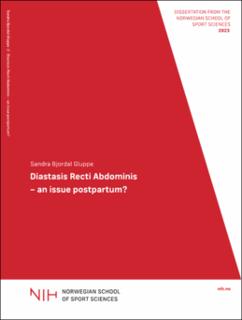| dc.contributor.author | Gluppe, Sandra Bjordal | |
| dc.date.accessioned | 2023-09-15T10:55:24Z | |
| dc.date.available | 2023-09-15T10:55:24Z | |
| dc.date.issued | 2023 | |
| dc.identifier.isbn | 978-82-502-0612-0 | |
| dc.identifier.uri | https://hdl.handle.net/11250/3089707 | |
| dc.description | Avhandling (doktorgrad) - Norges idrettshøgskole, 2023 | en_US |
| dc.description.abstract | Background: Diastasis recti abdominis (DRA) is defined as an impairment with midline separation of the two rectus abdominis muscles bellies along the linea alba. It is a prevalent condition in the postpartum period with prevalence rates between 30 − 68% but there is limited research on how women perceive DRA, the immediate effect of abdominal exercises on DRA, and its associated risks and consequences. Furthermore, there is no consensus on the effectiveness of abdominal exercises in treating DRA.
Methods and aims: This doctorial project consist of four different studies that examined various aspects of DRA postpartum. Study I surveyed 460 primiparous women 6-8 months postpartum to investigate how DRA is perceived and prevalence of self-reported abdominal muscle strength and experience of protrusion. Study II assessed the immediate effect of eight abdominal muscle exercises on inter-recti distance in 38 parous women with DRA. Study III compared prevalence of pelvic floor disorders, low back, pelvic girdle, and abdominal pain and abdominal muscle strength in age and parity matched women with (n=36) and without DRA (n=36). Lastly, study IV was an assessor blinded randomized controlled trial with 70 women diagnosed with DRA 6-12 months postpartum evaluating the effect of an abdominal exercise program, containing head lift, curl-up and twisted curl-up, on inter-recti distance. Furthermore, the effect on other possible consequences related to DRA was investigated.
Results and conclusion: In study I concerns about postpartum abdominal appearance was reported in 73.3%. Almost 80% experienced weaker abdominal muscles than pre-pregnancy. Protrusion was reported in 20.9%. Significantly more women with protrusion (93.8%) reported weaker abdominal muscles than women without protrusion (75.7%). The most frequently reported treatments for DRA were exercises for the PFM (84.1%) and abdominal muscles (82.9%), which was mostly accessed via social media. Study II found a statistically significant immediate decrease in inter-recti distance during the exercises head lift, curl-up and twisted curlup when compared to rest with mean difference in change to be 10.0 mm (95%CI 7.9-13.3), 8.7mm (95%CI 5.0-12.5), and 9.4mm (95%CI 6.3-12.5), respectively (measured 2 cm above the umbilicus). Study III found no difference in prevalence of pelvic floor disorders, low back and pelvic girdle pain between women with and without DRA. Significantly more women with DRA reported abdominal pain than women without DRA in the adjusted analyses (OR: 0.02, 95% CI 0.00 to 0.61, p=0.026). There was a significant difference in mean change between groups in maximal isometric strength at 30◦ (mean difference: −12.9 (95 % CI: −24.4, −1.5), p-value: 0.028). However, the adjusted analyses showed no difference in abdominal muscle strength between groups. In study IV 70% of the women who underwent screening and believed they had DRA, did not meet the IRD inclusion criteria (>2.8 cm at rest). The exercise program was not effective in reducing IRD, with a mean change between groups at rest (2 cm above the umbilicus) of 1.24 mm (95% CI -0.83, 3.31). However, maximal isometric abdominal strength was significantly increased, in favour of the exercise group, with a mean difference in change between groups at 30◦ of 6.25 Nm (95% CI 0.47, 12.04) and at 10◦ 7.55 Nm (95% CI 1.94, 13.17). Also, the increase in muscle thickness for the exercise group was statistically significant (p=0.046) with a difference in change between groups of 0.58mm (95% CI 0.01 to 1.14). There was no significant difference between the exercise and control groups at post-test was in number of women reporting pelvic floor disorders, low back, pelvic girdle, or abdominal pain. At post-test 61% of the women in the exercise group and 43% in the control group reported improvement in DRA by the global rating of change scale (p=0.16). None of the participants in either groups reported worsening of the condition. | en_US |
| dc.language.iso | eng | en_US |
| dc.relation.haspart | Paper I: Gluppe, S., Ellström Engh, M., & Bø, K. (2022). Primiparous women's knowledge of diastasis recti abdominis, concerns about abdominal appearance, treatments, and perceived abdominal muscle strength 6-8 months postpartum. A cross sectional comparison
study. BMC women's health, 22(1), 428. https://doi.org/10.1186/s12905-022-02009-0 | |
| dc.relation.haspart | Paper II: Gluppe SB, Engh ME, Bø K. Immediate Effect of Abdominal and Pelvic Floor Muscle Exercises on Interrecti Distance in Women With Diastasis Recti Abdominis Who Were Parous. Phys Ther. 2020 Aug 12;100(8):1372-1383. doi: 10.1093/ptj/pzaa070. PMID: 32302393. | |
| dc.relation.haspart | Paper III: Gluppe S, Ellström Engh M, Kari B. Women with diastasis recti abdominis might have weaker abdominal muscles and more abdominal pain, but no higher prevalence of pelvic floor disorders, low back and pelvic girdle pain than women without diastasis recti abdominis. Physiotherapy. 2021 Jun;111:57-65. doi: 10.1016/j.physio.2021.01.008. Epub 2021 Feb 13. PMID: 33691943. | |
| dc.relation.haspart | Paper IV: Gluppe S, Ellström Engh M, Kari B. Curl-up exercises does not decrease inter-recti distance but improve abdominal muscle strength in women with diastasis recti abdominis postpartum: a randomized controlled trial. Under review in Journal of Physiotherapy, 2023 Feb 17 | |
| dc.subject | nih | en_US |
| dc.subject | doktoravhandlinger | en_US |
| dc.title | Diastasis Recti Abdominis: An issue postpartum? | en_US |
| dc.type | Doctoral thesis | en_US |
| dc.description.version | publishedVersion | en_US |
| dc.description.localcode | Institutt for idrettsmedisinske fag / Department of Sports Medicine | en_US |
